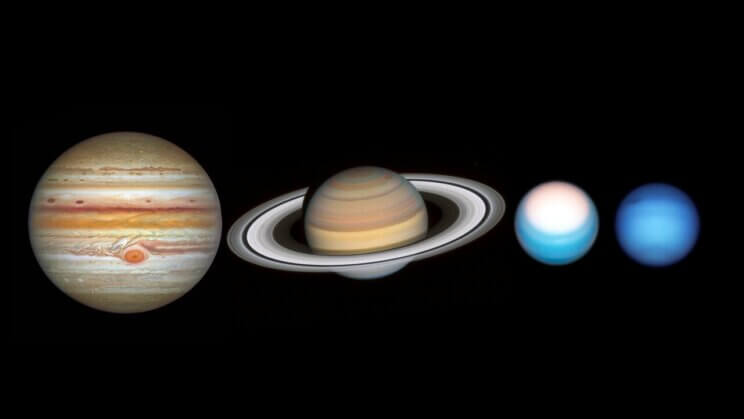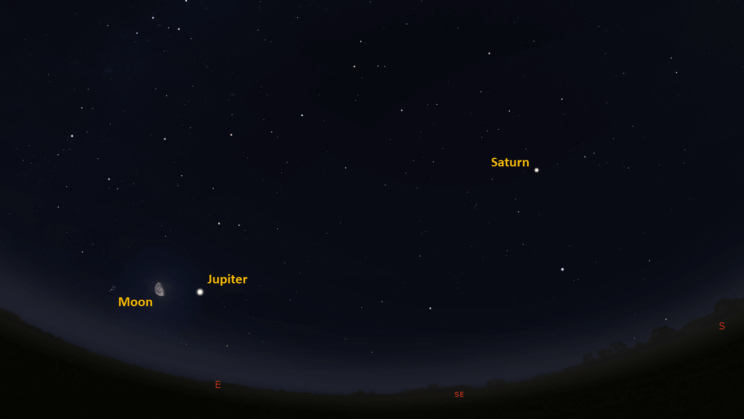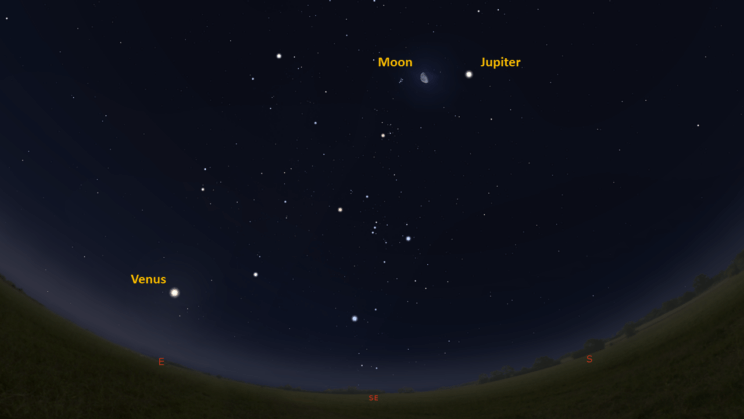This is the Saint Louis Science Center’s NIGHT SKY UPDATE for the week of Saturday, September 2, 2023.
Information updated weekly or as needed.
Times given as local St. Louis time which is Central Daylight Time (CDT). For definitions of terminology used in the night sky update, click the highlighted text. If relying on times posted in Universal Time (UT), St. louis is -5 hours when CDT.
Public Telescope Viewings
As part of the Saint Louis Science Center’s First Fridays, weather permitting, the St. Louis Astronomical Society and the Science Center will set up a number of telescopes outdoors and be on-hand to answer your questions. Telescope viewing begins once it is dark. Regardless of the weather on October 6 , join us indoors in our planetarium theater for “The Sky Tonight”. Showtime is at 7 p.m. There is no First Friday event in July.
Observing Highlight of the Week

The outer planets of our solar system as seen by the Hubble Space Telescope in 2021. Views like these allow scientists to study weather and seasonal changes in the atmospheres of these giant worlds. Image credit: NASA, ESA, A. Simon (Goddard Space Flight Center), and M.H. Wong (University of California, Berkeley) and the OPAL team.
This September is the time of giant planets. For those interested in spotting these planets all four are visible now by 11:30 p.m. While two are visible naked eye and all four are binocular targets, a telescope is your best option for viewing Jupiter, Saturn, Uranus and Neptune.
Jupiter and Saturn are the largest planets in our solar system at 11x and 9x the size of Earth. They are called gas giants because they are comprised of mostly hydrogen and helium with small cores of rock and ice. Uranus and Neptune are the ice giants of our solar system both at roughly 4x the size of Earth. Ice giants have an atmosphere of hydrogen helium and methane, but they also have some heavier elements such as oxygen, carbon, nitrogen and sulfur. Their mantles are mostly a slushy mixture of water and ammonia overlaying a large core of rock and ice.
Saturn and Neptune are the first to rise. Saturn reached opposition on August 27, 2023, which means it now rises before the Sun sets. If you have a reasonably clear view of the southeast, you should be able to spot Saturn easily by 9:00 p.m. Opposition is when an object appears near the antisolar point in the sky. Another way to think of this is the object appears opposite the Sun. From our view on Earth, only objects that can be farther from the Sun will reach opposition.
A good example is the Moon. For a portion of its orbit, the Moon is farther from the Sun than Earth is. The Moon reaches opposition when it reaches its full phase. When an object reaches opposition, it will appear brighter due to the opposition effect. This happens because shadows cast by objects on the target’s surface are pointed away from the viewer. In this scenario, there would are more bright surfaces than dark causing the target to appear brighter. Mars reaches opposition every 26 months, while Jupiter, Saturn, Uranus and Neptune do it once a year. Superior planets are best viewed when near opposition.
Neptune will reach opposition on September 19, 2023. When it is near opposition, it is possible to spot Neptune with binoculars. You will need a star chart that has a limiting magnitude of 8 or higher. If you do not have this kind of atlas, you can use the free planetarium software called Stellarium. It is available for all platforms and is a great tool for planning observing sessions.
Of the two Saturn will be the best. Its rings, and few of its moons can be seen in small backyard telescopes. Neptune on the other hand will appear as a dim star like object. To confirm you have found Neptune, it will appear as a disk while stars will be points of light.
Jupiter and Uranus rise later in the night becoming visible for most after 11:00 p.m. Jupiter reaches opposition on September 26, 2023, and Uranus will reach opposition on November 13, 2023.
Jupiter is best seen when at opposition, but the improvement will not be as drastic as it is for the other superior planets. Jupiter is always bright enough that telescope views are always great. Binoculars will reveal four of Jupiter’s 95 moons and a small telescope will reveal the largest cloud banding seen in its atmosphere. Those with moderate sized telescopes can easily see Jupiter’s Great Red Spot (GRE) provided it is in transit when observing. Jupiter rotates once every 10 hours. Because of this, the GRE is not always pointed at Earth. There are two decent GRE transits visible from St. Louis this week. Both occur over early morning hours on September 6 and 9.
Uranus reaches opposition on November 13, 2023. While Uranus will always be best seen through a telescope, if it is near opposition, it is bright enough to see with the unaided eye. Currently, Uranus has an apparent magnitude of 5.7. This puts it within naked eye visibility if viewing from a dark site while urban observers can spot it in binoculars. If using a telescope, you might notice Uranus appears a yellowish-green color. While the planet truly appears greenish-blue due to methane in its atmosphere, distortions caused by Earth’s atmosphere impact the appearance of what we see.
All four planets are worth tracking down if you get the chance. Currently you will find Saturn in Aquarius, Neptune in Pisces and both Jupiter and Uranus in Aries. Like the Sun and Moon, planets will wander through the zodiac constellations. How long they take depends on how far from the Sun they are. Jupiter takes 12 years, Saturn takes 29.5 years, Uranus takes 84 years and Neptune takes 164 years. If you are interested in spotting these planets, a good first step is to learn how to find these constellations.
The Sun and Moon

The Moon as seen from the International Space Station, on July 31, 2011.
Credit: NASA
Sun
Sunrise is at 6:31 a.m. on Saturday, September 2 and sunset is at 7:29 p.m. providing us with roughly 13 hours of daylight. Even after sunset, light from the Sun will dimly illuminate our sky for about 1 hour and 30 minutes. This period is called twilight, which ends around 9:03 p.m. this week. For those with a sundial, local noon occurs around 1:00 p.m. this week.
| Day | Sunrise | Sunset | ||||||||||
|---|---|---|---|---|---|---|---|---|---|---|---|---|
| 2-Sep | 6:31 a.m. | 7:29 p.m. | ||||||||||
| 3-Sep | 6:32 a.m. | 7:28 p.m. | ||||||||||
| 4-Sep | 6:32 a.m. | 7:26 p.m. | ||||||||||
| 5-Sep | 6:33 a.m. | 7:25 p.m. | ||||||||||
| 6-Sep | 6:34 a.m. | 7:23 p.m. | ||||||||||
| 7-Sep | 6:35 a.m. | 7:22 p.m. | ||||||||||
| 8-Sep | 6:36 a.m. | 7:20 p.m. | ||||||||||
| 9-Sep | 6:37 a.m. | 7:19 p.m. | ||||||||||
| 10-Sep | 6:38 a.m. | 7:17 p.m. |
Moon
Moonrise for Saturday, September 2 was at 9:10 p.m. and moonset occurs at 10:42 a.m. on the following day. On Saturday, September 2, the Moon will exhibit a waning gibbous phase with 88% disk illumination. Last quarter moon occurs on September 6, 2023, at 5:21 p.m.
International Space Station (ISS) Observing

There are several visible passes of ISS from St. Louis for the week of September 2. They occur during morning hours. Use the table below for information about these passes.
Catch ISS from St. Louis starting Saturday, September 2
| Date | Starts | Max. altitude | Ends | |||||||
|---|---|---|---|---|---|---|---|---|---|---|
| Time | Alt. | Az. | Time | Alt. | Az. | Time | Alt. | Az. | ||
| 08 Sep | -3.8 | 5:34:00 | 10 | NW | 5:37:21 | 84 | NE | 5:40:41 | 10 | SE |
| 09 Sep | -2.9 | 4:47:46 | 36 | N | 4:48:37 | 46 | NE | 4:51:52 | 10 | ESE |
Magnitude (Mag): The Measure of brightness for a celestial object. The lower the value is, the brighter the object will be.
Altitude (Alt): The angle of a celestial object measured upwards from the observer’s horizon.
Azimuth (Az): The direction of a celestial object, measured clockwise from an observer’s location with north being 0°, east being 90°, south being 180° and west being 270°.
Detailed information regarding all unmanned exploration of our universe, missions past, present, and planned, can be found at Jet Propulsion Laboratories:
The Visible Planets

Looking southeast at 11:30 p.m. on September 4, 2023. Credit: Stellarium, EG

Looking southeast at 5:30 a.m. on September 5, 2023. Credit: Stellarium, EG
This week, four naked eye planets will be visible. Mars is still visible in the west about 30 minutes after sunset. It will be low so twilight will make spotting Mars challenging. Saturn and Jupiter will be easy to find but you will have to go out in the late evening hours to spot them. Saturn will be in the southeast around 9:00 p.m., while Jupiter will be in the east by 11:00 p.m. Lastly, Venus has started a new morning apparition. Early birds should be on the lookout for the bright planet by 5:30 a.m. in the east.
Venus
Venus’s next morning apparition has begun. To find Venus, look east around 5:30 a.m. It will still be low so trees and buildings will make spotting the planet difficult. If you have a clear view of the planet, binoculars will reveal a thin crescent phase with roughly 15.1% disk illumination.
Mars
Mars now rises before sunset, becoming visible once it is dark. Look for it in the west about 30 minutes after sunset. Mars sets at 8:21 p.m.
Jupiter
Jupiter rises at 10:08 p.m. About one hour after Jupiter rises, it should be easy to spot. Jupiter will rise about 30 minutes earlier each week.
Saturn
Saturn rises at 7:07 p.m. Start looking for Saturn about 30 minutes after sunset. If you have lots of trees or buildings, you may have to wait an hour or so after it rises before it will be visible.
James S. McDonnell Planetarium
Night Sky Update: September 2-10, 2023






